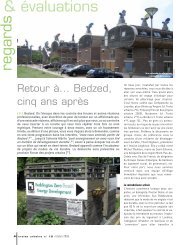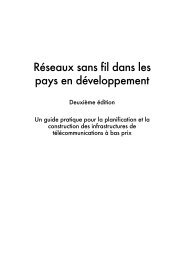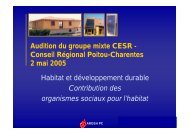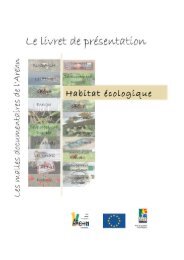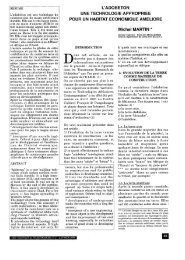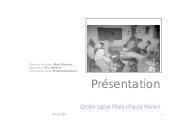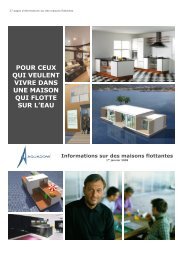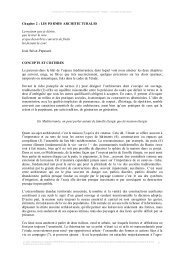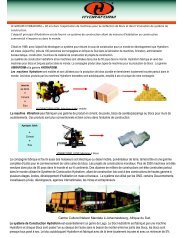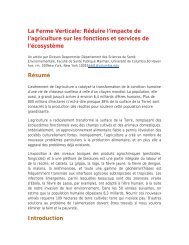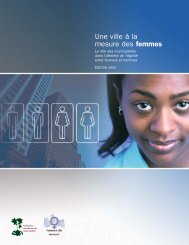- Page 1 and 2:
UNIVERSITE CHEIKH ANTA DIOP DE DAKA
- Page 3 and 4:
REMERCIEMENTS Je remercie toutes le
- Page 5:
Avis au lecteur Etant donné notre
- Page 8 and 9:
III.2.1 Une recherche de solutions
- Page 10 and 11:
III.3 Inventaire des facteurs inter
- Page 12 and 13:
I.1.1 D’abord, sur l’échantill
- Page 14 and 15:
Aussi, dans le cadre d’une meille
- Page 16 and 17:
- les besoins et la demande des hab
- Page 19:
PREMIERE PARTIE : PROBLEMATIQUE Pou
- Page 22 and 23:
citadin proche en produits frais et
- Page 24 and 25:
dans les "City garden" de Lechtwort
- Page 26 and 27:
d’Europe. Pour que l’agricultur
- Page 28 and 29:
Carte 2. Ceinture de verdure d’Ot
- Page 30 and 31:
Carte 4. Dix projets agriurbains en
- Page 33 and 34:
II. II.1 L’agriculture urbaine :
- Page 35 and 36:
fondant sur la « formation des vil
- Page 37 and 38:
Enfin, une des définitions de l’
- Page 39 and 40:
compte de l’agriculture par le pr
- Page 41 and 42:
II.2 l’agriculture urbaine, une a
- Page 43 and 44:
alimentaire: c’est le cas de la p
- Page 45 and 46:
III. Le concept de multifonctionnal
- Page 47 and 48:
ou, au pire, comme une réserve fon
- Page 49 and 50:
sans mal que la sécurité d’appr
- Page 51 and 52:
quelques mois avant les négociatio
- Page 53 and 54:
Ensuite, la vision agronomique. Ell
- Page 55 and 56:
Dans le cadre des pays en développ
- Page 57 and 58:
Chapitre 2. LE CONTEXTE : DAKAR L
- Page 59:
I.2 Le centre nerveux du pays doubl
- Page 62 and 63:
Dès lors, commence la "débrouilla
- Page 64 and 65:
Carte 10. Extension spatiale de Pik
- Page 66 and 67:
Carte 11. "Les grands projets" en c
- Page 68 and 69:
C’est l’Etat qui est détenteur
- Page 70 and 71:
III. Le PASDUNE : une volonté éta
- Page 72 and 73:
Photo 1. Exploitation du sel sur le
- Page 74 and 75:
III.2 Naissance et réalisations du
- Page 76 and 77:
Carte 13. "Niaye de Pikine" ; illus
- Page 78 and 79:
Pour concrétiser tout cela, un pla
- Page 80 and 81:
En résumé, on voit que d’un cô
- Page 83 and 84:
Chapitre 3. JUSTIFICATION DU SUJET
- Page 85 and 86:
II. Le projet de thèse Bien que, v
- Page 87:
DEUXIEME PARTIE : MATERIEL ET METHO
- Page 90 and 91:
Carte 15. Croquis urbain de la rég
- Page 92 and 93:
II. Identification de zones particu
- Page 94 and 95:
II. L’échantillonnage des autres
- Page 96 and 97:
I.2 Les enquêtes de terrain Nous a
- Page 98 and 99:
II. Le dépouillement des données
- Page 101:
PREMIERE SECTION : LES REPRÉSENTAT
- Page 104 and 105:
Fonctions_Niayes pour Elus (13), en
- Page 106 and 107:
III. La fonction « emplois/revenus
- Page 109 and 110:
Chapitre 2 : GARDER LES NIAYES ? ET
- Page 111 and 112:
zones dans la création d’emplois
- Page 113 and 114:
- Enfin, en 2005, nous avons demand
- Page 115 and 116:
DEUXIEME SECTION : PRESENTATION DES
- Page 117 and 118:
Chapitre 1. PRESENTATION DETAILLEE
- Page 119 and 120:
I. Typologie des producteurs I.1 Ob
- Page 121 and 122:
I.1.2 Méthode de classification et
- Page 123 and 124:
I.1.3 Classification et caractéris
- Page 125 and 126:
Nous n’aurons pas à considérer
- Page 127 and 128:
environnement socio-économique, ch
- Page 129 and 130:
I.1.3.1.4 Le capital financier inve
- Page 131 and 132:
I.1.4 Les types de systèmes de pro
- Page 133 and 134:
Les principaux enseignements qu’o
- Page 135 and 136:
I.2 Les types de systèmes de produ
- Page 137 and 138:
Le mur de la concession Photo 4. Ta
- Page 139 and 140:
Cependant, concernant la destinatio
- Page 141 and 142:
Pour les légumes feuilles : On dis
- Page 143 and 144:
Une partie de la production est aut
- Page 145 and 146:
Les éleveurs "purs" : AEl Par déf
- Page 147 and 148:
Commentaire des "purs" de pleine te
- Page 149 and 150:
Les pêcheurs : CPê - Ils débarqu
- Page 151 and 152:
I.2.2.2 Les types de systèmes de p
- Page 153 and 154:
14 fois le nombre de salariés sais
- Page 155 and 156:
Les doubles et le triple éleveurs
- Page 157 and 158:
Les éleveurs-maraîchers : BElMa T
- Page 159 and 160:
Les éleveurs-maraîchers : CElMa T
- Page 161 and 162:
Récapitulatif et commentaires sur
- Page 163 and 164:
terre reste décisif pour le dével
- Page 165 and 166:
Les intrants * Pour les intrants, m
- Page 167 and 168:
I.3.3 Vue transversale des système
- Page 169 and 170:
- L’effectif total des types de p
- Page 171 and 172:
evenu en prenant un emploi dans la
- Page 173 and 174:
II. Localisation des types d’agri
- Page 175 and 176:
Barrage. Ils sont ensuite présents
- Page 177 and 178:
Tableau 37. Récapitulatif sur la l
- Page 179 and 180:
Enfin, nous constatons que la zone
- Page 181 and 182:
- Lorsqu’ils sont "mixtes", ils s
- Page 183 and 184:
III. La durabilité de l’agricult
- Page 185 and 186:
l’exclusion des systèmes de prod
- Page 187 and 188:
Les types C, les microjardiniers :
- Page 189 and 190:
constater qu’ils ont surestimé l
- Page 191 and 192:
Ce graphique montre que, parmi les
- Page 193 and 194:
Les pêcheurs "purs" : APê Ils év
- Page 195 and 196:
III.3.2.2 diagnostic de durabilité
- Page 197 and 198:
sécurité foncière qui se traduit
- Page 199 and 200:
* Pour les types C Les maraîchers
- Page 201 and 202:
III.3.3 Commentaire global sur la d
- Page 203 and 204:
viennent les maraîchers-floriculte
- Page 205 and 206:
III.3.5.2 Pour les types de systèm
- Page 207 and 208:
a-t-on (i) correctement établi leu
- Page 209 and 210:
. La « zone intra-urbaine de Niaye
- Page 211 and 212:
Chapitre 2. PRESENTATION DES DONNÉ
- Page 213 and 214:
I.2.2.2 Lieux de vente des produits
- Page 215 and 216:
- Le premier graphique montre que,
- Page 217 and 218:
le piment et le poivron pour les ba
- Page 219 and 220:
‣ Ces légumes leur fournissent p
- Page 221 and 222:
II. II.1 Typologie des consommateur
- Page 223 and 224:
II.2.1.3 La taille des ménages sui
- Page 225 and 226:
En croisant les réponses avec la q
- Page 227 and 228:
‣ Les fréquences d’achat Le cr
- Page 229 and 230:
‣ Les prix des légumes de Niayes
- Page 231 and 232:
Prix des légumes de microjardins F
- Page 233 and 234:
QUATRIEME PARTIE : DISCUSSION Nous
- Page 235 and 236:
Chapitre 1. RETOUR SUR LES RESULTAT
- Page 237 and 238:
I.1.3 Pour les décideurs Autant po
- Page 239 and 240:
Le déchet urbain est toujours cons
- Page 241 and 242:
Programme, que par ses niveaux de p
- Page 243 and 244:
Chapitre 2. CONFRONTATION DES RESUL
- Page 245 and 246:
I.3 Une étude qui a montré un dé
- Page 247 and 248:
II. II.1 Par rapport à la caracté
- Page 249 and 250:
(cela évoque le déplacement des H
- Page 251 and 252:
Chapitre 3. LES LIMITES DE L’ETUD
- Page 253 and 254:
II. II.1 Ses perspectives scientifi
- Page 255 and 256:
CONCLUSION GÉNÉRALE Dakar connaî
- Page 257 and 258:
de l’agriculture intra et périur
- Page 259 and 260:
RÉFÉRENCES BIBLIOGRAPHIQUES OUVRA
- Page 261 and 262:
Moustier P., Danso G., (2006). « L
- Page 263 and 264:
Bryant C. R., (1974). « The antici
- Page 265 and 266:
Massot-Marti A., (2003). (Administr
- Page 267 and 268:
Delache X., (2002). (Document étab
- Page 269 and 270:
Navarro-Garza H., Olivares-Rodrigue
- Page 271 and 272:
Snrech S., (1997). Croissance démo
- Page 273 and 274:
République du Sénégal. Ministèr
- Page 275 and 276:
http://www.primature.sn/senegal/pop
- Page 277 and 278:
LISTE DES TABLEAUX Tableau 1. Conse
- Page 279 and 280:
LISTE DES ENCADRÉS Encadré 1. Les
- Page 281 and 282:
LISTE DES PHOTOS Photo 1. Exploitat
- Page 283 and 284:
Graphique 32. Légumes tubercules l
- Page 285 and 286:
GIE : Groupement d’Intérêt Éco
- Page 287 and 288:
LISTE DES ARTICLES ET PARTICIPATION
- Page 289 and 290:
ANNEXES SIGNALEES DANS CE DOCUMENT
- Page 291 and 292:
I.8 Région de dernière résidence
- Page 293 and 294:
II.1.25 Quels sont la nature et le
- Page 295 and 296:
II.2.6 Quels sont les légumes-gous
- Page 297 and 298:
II.2.15 Combien de kilos de produit
- Page 299 and 300:
II.2.29 Quelles sont les principale
- Page 301 and 302:
II.2.31 Quelles sont les cinq princ
- Page 303 and 304:
II.4.2 Quelles sont la nature et la
- Page 305 and 306:
III.2.5 Seriez-vous prêts à recev
- Page 307 and 308:
III.1.4 De quelle (s) région (s) p
- Page 309 and 310:
3. Questionnaire et guide d’entre
- Page 311 and 312:
II.4 Où et à quelle fréquence ve
- Page 313 and 314:
4. Questionnaire et guide d’entre
- Page 315 and 316:
III.5 Quels sont les trois produits
- Page 317 and 318:
5. Guide d’entretien_élu_2005 ID
- Page 319 and 320: 6. Guide d’entretien_élu_2006 ID
- Page 321 and 322: III.2.6 Pensez-vous que le PASDUNE
- Page 323 and 324: III.2 Selon vous, quelle utilité a
- Page 325 and 326: SECTION 3. PLACE DE L’AGRICULTURE
- Page 327 and 328: II.5 Quelle est la superficie resta
- Page 329 and 330: ANNEXE 2 : "CODAGES_regroupements"
- Page 331 and 332: ANNEXE 5 : détail du matériel et
- Page 333 and 334: ANNEXE 8 : espèces d’arbres cult
- Page 335 and 336: Les productions : il ne cultive que
- Page 337 and 338: Les productions : concernant les l
- Page 339 and 340: NB : le N° 181 est un cas particul
- Page 341 and 342: B.3.4 Le Riziculteur : CRiP (N° 10
- Page 343 and 344: - 5 sont moyens avec entre 100 et 4
- Page 345 and 346: 5 utilisent des produits compostés
- Page 347 and 348: Les productions : Le N° 108 est pl
- Page 349 and 350: - 2 sont propriétaires : les N° 1
- Page 351 and 352: ANNEXE 10 : tableau des plantes orn
- Page 353 and 354: ANNEXE 13 : inventaire des facteurs
- Page 355 and 356: Les types B Les maraîchers-floricu
- Page 357 and 358: AElMa = 3 vivabilité et transmissi
- Page 359 and 360: Avantage à produire près de la vi
- Page 361 and 362: ANNEXE 15 : des exemples des docume
- Page 363 and 364: 351
- Page 365 and 366: 353
- Page 367 and 368: ANNEXE 16 : ensemble des zones de n
- Page 378: Résumé A l’instar de ce qui est



